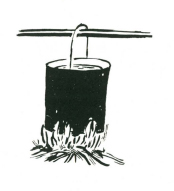
In very windy or cold conditions it is worth making a reflector fireplace for your cooking. A few green logs placed as a windbreak to the windward side of your fire will enable you to do your cooking in comfort.
FIRE IN FLOODED AREAS
Fire can be made in areas totally covered with flood waters. The essential is to build a small platform above water level and on this light your fire.
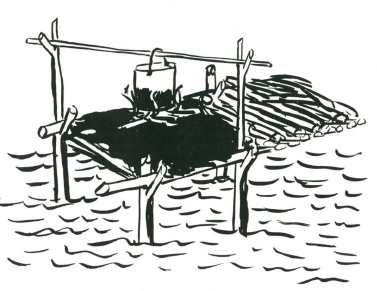
The easiest way to do this is to cut four forked stakes. These must be straight along the line of drive with the fork projecting; from the side. They must be long enough for the fork to be about 6 to 12 inches above the level of water after the stakes are driven into the ground.
Across the forks at either end two cross sticks are laid, and on these two sticks a platform of other sticks is placed, side by side. These are covered with a couple of inches of mud, and on this the fire is built.
By extending the platform a foot or two at one end, you have a storage place for your firewood.
FIRE FOR WARMTH
If sleeping out without sleeping; bags or any bedding, select the site for your fire against a dead log. (But make sure the log is not a hiding place for snakes.) Rarely will a single log, burn by itself unless there is a strong draught blowing onto it; therefore you must feed the fire with at least one other log. This can be done by selecting a solid, fairly long log, eight or nine inches through if possible and six or seven feet long. By pushing the end of this against the bigger log where you have built your fire, you will ensure continued burning, and as the smaller log burns down during the night you can simply push it against the big log, and the fire will take fresh heart. An alternative is to lay your logs like a star, and push the ends together during the night.
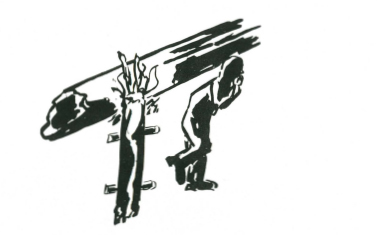
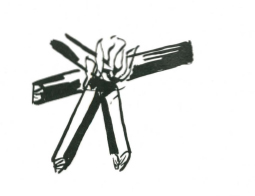
A small log pushed against a dead fallen tree will give you a good overnight sleeping fire. But be sure to put it out in the morning!
THE BUILDING OF A CAMP FIRE
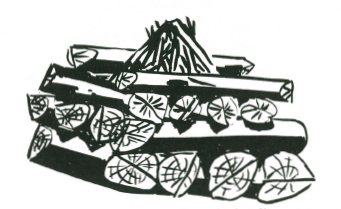
Solid Fire. Pyramid fire, lit on top.
This is the best of all campfires. Three or four logs about 3 ft. to 5 ft. long are laid side by side and across them another layer with, if you desire it, a third layer on top of these. On top of the top layer the starting fire is laid. This is built up finally like a small pyramid. This type of fire is lit at the top. The starter fire ignites the logs below with falling coals and so this fire burns downwards. It radiates heat evenly all round, and requires no attention during the night. Also, because there is no falling in of the fire the risk of sparks spreading and starting a bushfire is greatly minimised.
A common mistake in building a campfire is to make a ‘pigsty’ construction with heavy logs, on the outside and then pack the inside with light brushwood. Such fires are rarely a success. The light inside wood burns out in a quick blaze of glory, but the heavy outer logs lack sufficient heat to get them properly alight, and also having only small points of contact with each other at the corners do not burn well nor do such fires give out a good radiation of heat. If the 'pigsty' method is to be used, the top two layers should be completely across the top, one layer going in one direction and the other layer crossing it. These top two layers, when alight, get plenty of air from underneath after the brushwood has burnt out and the heat generated will be reflected downwards, giving better radiation than with a simple ‘pigsty’ construction.
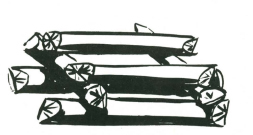
Pigsty fire properly built.
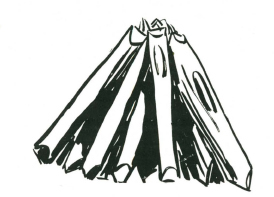
Cone fire.
A good camp fire is built if the wood is standing end on, and the fire is built like a pyramid or cone. The centre is fired, and as the core burns away the outside logs fall inwards, constantly feeding the heart of the fire. This type of fire gives good radiation and even with wet wood burns well.
SLOW MATCH
A slow match is a length of rope or cord which hangs in a smouldering condition to give fire when wanted. (Breech loading guns were fired by touching off the priming with a slow match.)
Today the slow match principle is used by many primitive people as a means of preserving fire and also as a means of carrying it from place to place.
A slow match can be made by making a length of cord or thin rope (from 1/8-inch to ¼-inch diameter) from suitable barks or palm fibres.
Most of the ‘silky’ soft-fibred barks are ideal. When one end is put in fire or against a glowing coal it will take and hold the spark, smouldering slowly.
A slow match is a safe way when you have no matches or fire-lighting material, to preserve the vital spark for further use after you have doused your fire and left camp for an hour or two. For such a use the slow match should be hung from a branch and exposed to the currents of air.
FIRE IN WET WEATHER
The inclusion in your camp gear of firemaking aids such as a few Meta (dried alcohol) tablets is a matter of foresight which you will appreciate if you are overtaken by very bad weather.
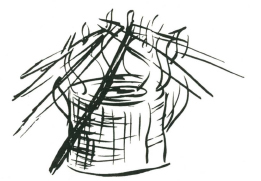
Kerosene-soaked Bandages
One of the really useful fire aids is a kerosene-soaked bandage. The kerosene does not affect the bandage–rather it acts as an antiseptic and helps keep the bandage sterile, and, if need arises, the kerosene-soaked bandage can be used to start a fire in very wet weather.
The best way is to pour kerosene into the roll of bandage until the roll is thoroughly saturated, but not to excess, or the ‘dripping’ stage. The bandage can then be put back again into the first-aid kit.
FIRE PRECAUTIONS
Observe these campfire rules and you will never start a bush fire.
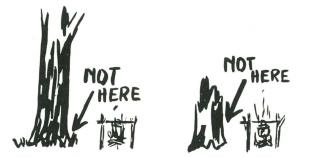
NEVER LIGHT A FIRE AT THE FOOT OF A STANDING TREE OR TREE STUMP.
NEVER LIGHT A FIRE YOU CANNOT PUT OUT.
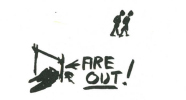
NEVER LEAVE A FIRE BURNING WHEN YOU LEAVE CAMP.

ALWAYS CLEAR AN AREA THREE FEET WIDE AROUND YOUR FIREPLACE.
Whenever possible, enclose your fire, either with stones, by using a pit fireplace, or by using a couple of green logs.
BUSHFIRE FIGHTING
There are two main types of bushfires. Most frequent is a ‘ground’ fire in which the fire sweeps along the ground and lower growth, feeding upon the fallen leaves and grass and shrubs. The other type is a ‘Tops’ or true ‘forest’ fire, in which the fire sweeps along the tree tops, the leaves of which, because of the intense heat, are rendered highly inflammable. Forest fires move with great speed, and because of terrific air currents which they generate, ‘jump’ considerable distances.
Most bush fires start as ground fires. When the weather is dry and hot, a ground fire can quickly grow to a forest fire in heavily-timbered country.
GROUND FIRES
A ground fire can be fought either by beating it out or by making a fire break. SYS
If the fire is purely a grass fire, use a green leafy branch to attack the fire by beating the burning edge back towards the burnt portion. When bush and low scrub are alight you may be able to beat the fire out with the green branch, but if possible a length of sacking, thoroughly soaked, will prove a more efficient beater.